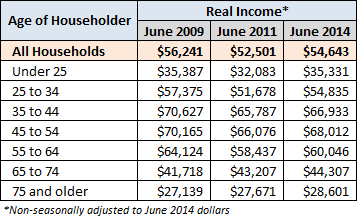Courtesy of Doug Short.
Last week Sentier Research released its blockbuster report, Household Income on the Fifth Anniversary of the Economic Recovery: June 2009 to June 2014. I’ve explored the details of some of their findings in a couple of commentaries that focused on income by age, race & ethnicity, household types and educational attainment (here and here).
In this commentary I’ll focus on the improvements in real household incomes since the post-recession trough, which occurred in the summer of 2011. For openers, here is a snapshot of real median household income since 2007. I’ve scaled the vertical axis to zero for June 2009, the month that the NBER established as the start of the recovery.

In the chart above, the seasonally adjusted trough in August was 6.8% below the level in the month the recovery started. Following that low, there has been a trend of higher lows, as we begin to see an upward drift in the monthly highs beginning in June 2013. As of June 2014, the real median income has trimmed a bit over half the post-recession decline.
An Unequal Recovery: The Young, the Old and Everyone Else
 When we look at the data by age cohorts, we see that the income growth during the recovery has not be distributed evenly across the generations. The adjacent table features the non-seasonally adjusted real data by age groups on the second and fifth anniversaries of the recovery. The non-seasonally adjusted second anniversary, in June 2011, was two months before the seasonally adjusted monthly trough for all households.
When we look at the data by age cohorts, we see that the income growth during the recovery has not be distributed evenly across the generations. The adjacent table features the non-seasonally adjusted real data by age groups on the second and fifth anniversaries of the recovery. The non-seasonally adjusted second anniversary, in June 2011, was two months before the seasonally adjusted monthly trough for all households.
For a visualization of the changes, the first chart illustrates the data points for the cohorts across all three time frames. The focus is on the percent change from the 2009 recovery start. We quickly see that that the two oldest cohorts have fared best — a fact that is to a significant degree related to Social Security benefits, which enjoyed cost-of-living adjustments.

However, the trends have undergone a substantial change since mid-2011. The two youngest cohorts have seen the biggest increases in median household incomes, with the under-25 group up a whopping 10.1% over the past three years.

No doubt a key driver in the larger percent gain of the younger households is their general availability for employment at lower wages.
For more information on the post-recession trends in median household incomes, see the Sentier Research report itself:
- Household Income on the Fifth Anniversary of the Economic Recovery:
June 2009 to June 2014
Anyone interested should study the full report, which is available for a small fee here on the Sentier Research website.



